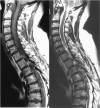Solitary spinal artery aneurysms as a rare source of spinal subarachnoid hemorrhage: potential etiology and treatment strategy
- PMID: 15709145
- PMCID: PMC7974078
Solitary spinal artery aneurysms as a rare source of spinal subarachnoid hemorrhage: potential etiology and treatment strategy
Abstract
Solitary aneurysms of spinal arteries lacking associated vascular malformations are rare. We report three patients with spinal subarachnoid hemorrhage (SAH) due to rupture of such aneurysms, which regressed spontaneously, as confirmed on conventional angiography. One patient had spinal SAH with presumed spontaneous dissection of a segmental artery. In the other two, SAH resulted from ruptured fusiform aneurysms of the artery of Adamkiewicz immediately proximal to the anterior spinal artery. Solitary aneurysms of the spinal arteries appear to be etiopathologic entities completely different from intracranial aneurysms. Spontaneous occlusion seems to be common, justifying a wait-and-see strategy rather than urgent treatment.
Figures







References
-
- Djindjian M. cited in: Berenstein A, Lasjaunas P. Spine and spinal cord vascular lesions. In: Surgical Neuroangiography. Berlin: Springer-Verlag;1992. :33
-
- Garcia CA, Dulcey S, Dulcey J. Ruptured aneurysm of the spinal artery of Adamkiewicz during pregnancy. Neurology 1979;29:394–398 - PubMed
-
- Elder ME, Lin D, Clever J, et al. Human severe combinedimmunodeficiency due to a defect in ZAP-70, a T cell tyrosine kinase. Science 1994;264:1596–1599 - PubMed
-
- Rengachary SS, Duke DA, Tsai FY, Kragel P. Spinal arterial aneurysm: case report. Neurosurgery 1993;33:125–130 - PubMed
Publication types
MeSH terms
LinkOut - more resources
Full Text Sources
Medical
